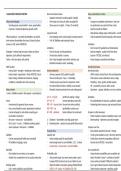7 ANALYSING STRATEGIC POSITION Short term financial status Value and limitations of ratios
- Suppliers interested in working capital + liquidity Value
Mission and strategies - More liquid, turn into cash, better at paying bills - Compare to competitors performance + past own
- Overall purpose, owners beliefs + values, opportunities - Shows sources of capital – LT loans, ST overdrafts - See performance over period of time, trends
- Corporate + functional objectives (growth, profit) - Need to account for inflation
Long term trends - Help decision making, longer credit periods = cash flo
Influencing factors – ownership (shareholders, non profit), - How changing, trends, raised capital, increasing reserves - Useful to potential investors (gearing), other busines
short termism (shareholders fast return), internal (culture, - S+W, NC liabilities need reducing in future
resources, CSR), external (PESTLEC) Limitations
Limitations - Don’t account for qualitative non financial data
Strategies = medium-long term plan of action to achieve - Point in the past, not help predictions - Internal strengths – quality of staff not shown
objectives, clearly defined in departments - No info about market / economy - External – PESTLEC not reflected
Tactics = short term plans, daily activity - Don’t value intangible assets (skills, motivate, exp) - Future changes not predicted with figures
- Bad debts included as assets, misleading
SWOT analysis Overall performance
- Internal audit = strengths + weaknesses, direct control Income statements Non-financial data
- External audit = opportunity + threats (PESTLEC), future - Revenue, expenses (PLCs publish to public) - SWOT analysis, internal factors from each departmen
- Helps strategy, individual circumstances, changing - Show accounting over 1 year, <1 misleading - Find reasons, resource allocation, culture, image
conditions, competitive adv, time consuming - Contain previous years data for comparison, trends - Marketing – share, growth, portfolio analysis
- No external/internal factors, inflation not accounted - HR – productivity, turnover, skills, morale
Balance sheets - Distorted, bring forward sales from next trading period - Operations – capacity, utilisation, unit cost, machiner
= assets + liabilities at point in time (equity + assets balance)
GP = R – VC (CoS) (profit from making + selling) Limitations
Assets OP = GP – FC (normal operations, banks risk) - No standardisation of measures, qualitative, subjecti
- Investments that generate future revenue PBT = OP – interest/other (income from other activities) - Monitoring diverts resources, past not predict future
- Non current (fixed) lose value, depreciation (machines) PAT = PBT – tax (profitability, investors use)
- Current exchange for cash within accounting year RP = PAT – dividends (internal finance for investment) Compare to other businesses
(receivables, inventories) - Similar enough to compare competitors, data in cont
- Net assets = total assets – total liabilities 1) Dividends – shareholders want high, good return - Benchmarking – implement successful strategies
- Net C assets = C assets – C liabilities (working capital) 2) Retained profits – spend to increase profits (fixed assets)
- Assets employed = total assets – C liabilities Compare over time
Financial ratios - Data analysis repeated at intervals = change
Liabilities Liquidity ratio - Trends, general patterns, long + short term performa
- Current need paying off within year (overdraft) - Needs working capital for good liquidity - Predict future trends by extrapolation, difficult to
- NC liabilities (mortgages, loans) - Need enough assets to cover liabilities, 1.5/2 : 1 is ideal forecast due to PESTLEC + uncertainty
- Current ratio = current assets / current liabilities
Bad debts Core competencies
- Not included on asset sheet, put as expense Profitability ratio - Unique features/capabilities, give competitive adv
- Shouldn’t be overoptimistic nor too cautious when plan - Shows profit margin, how much money made vs put in - Idea by Prahalad + Hamel – contribute to benefit?
- Compare ROCE to interest rate to see if better to save Access variety of markets? Difficult to replicate?
Working capital - Higher the better, improved by paying off debt/efficient - Easy to get confused, features standard expectation
- Cash + assets available to pay daily debts - ROCE% = OP / equity + NC liabilities (CE) x 100 - Other function outsourced = specialise, quality




